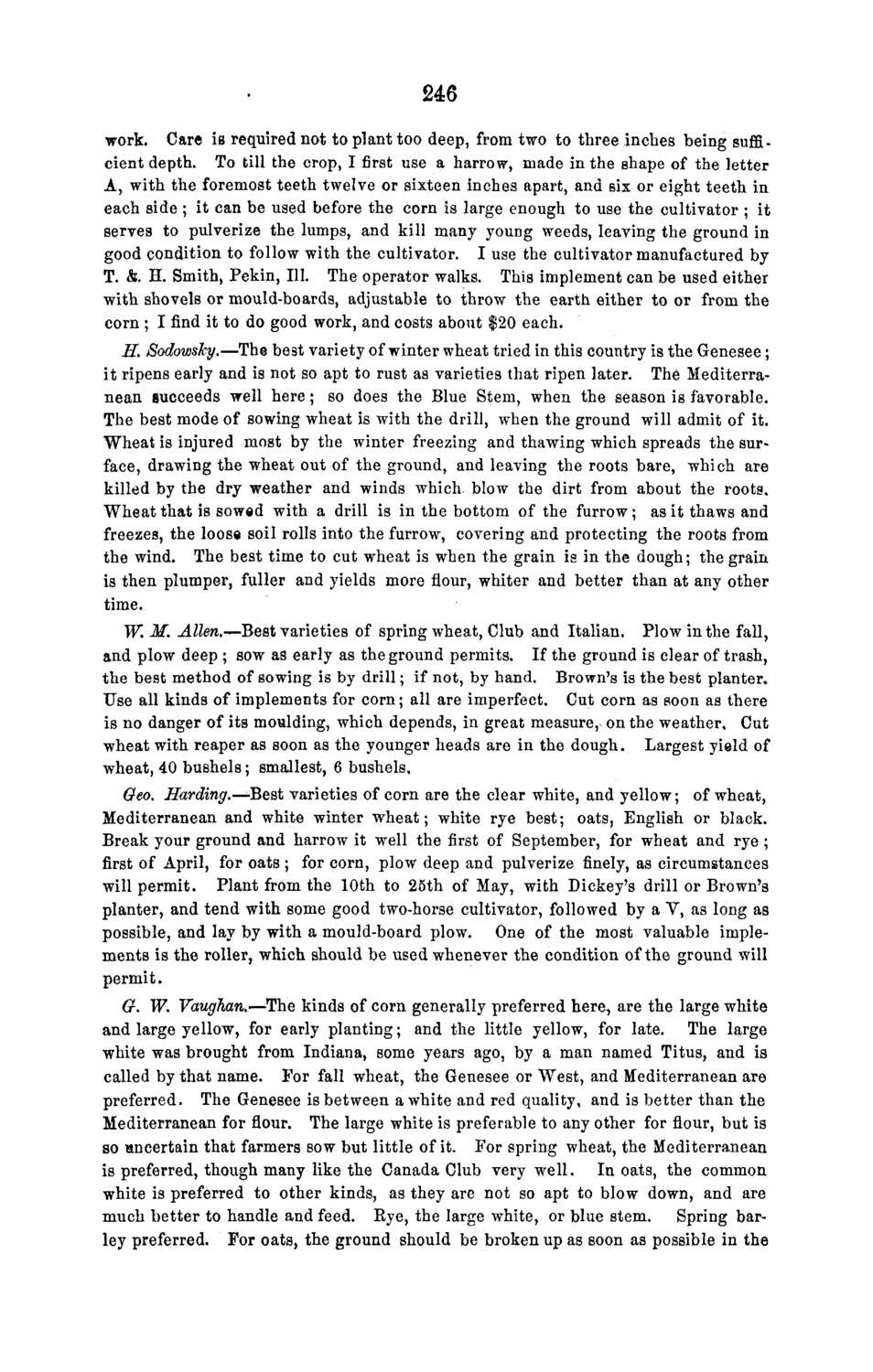| |
| |
Caption: Board of Trustees Minutes - 1868
This is a reduced-resolution page image for fast online browsing.

EXTRACTED TEXT FROM PAGE:
246 work. Care is required not to plant too deep, from two to three inches being sufficient depth. To till the crop, I first use a harrow, made in the shape of the letter A, with the foremost teeth twelve or sixteen inches apart, and six or eight teeth in each side ; it can be used before the corn is large enough to use the cultivator ; it serves to pulverize the lumps, and kill many young weeds, leaving the ground in good condition to follow with the cultivator. I use the cultivator manufactured by T. &. H. Smith, Pekin, 111. The operator walks. This implement can be used either with shovels or mould-boards, adjustable to throw the earth either to or from the corn ; I find it to do good work, and costs about $20 each. H. Sodowshy.—The best variety of winter wheat tried in this country is the Genesee; it ripens early and is not so apt to rust as varieties that ripen later. The Mediterranean succeeds well here; so does the Blue Stem, when the season is favorable. The best mode of sowing wheat is with the drill, when the ground will admit of it. Wheat is injured most by the winter freezing and thawing which spreads the surface, drawing the wheat out of the ground, and leaving the roots bare, which are killed by the dry weather and winds which blow the dirt from about the roots. Wheat that is sowed with a drill is in the bottom of the furrow; as it thaws and freezes, the loose soil rolls into the furrow, covering and protecting the roots from the wind. The best time to cut wheat is when the grain is in the dough; the grain is then plumper, fuller and yields more flour, whiter and better than at any other time, W. M. Allen,—Best varieties of spring wheat, Club and Italian. Plow in the fall, and plow deep ; sow as early as the ground permits. If the ground is clear of trash, the best method of sowing is by drill; if not, by hand. Brown's is the best planter. Use all kinds of implements for corn; all are imperfect. Cut corn as soon as there is no danger of its moulding, which depends, in great measure, on the weather. Cut wheat with reaper as soon as the younger heads are in the dough. Largest yield of wheat, 40 bushels; smallest, 6 bushels, Geo. Harding.—-Best varieties of corn are the clear white, and yellow; of wheat, Mediterranean and white winter wheat; white rye best; oats, English or black. Break your ground and harrow it well the first of September, for wheat and rye ; first of April, for oats; for corn, plow deep and pulverize finely, as circumstances will permit. Plant from the 10th to 25th of May, with Dickey's drill or Brown's planter, and tend with some good two-horse cultivator, followed by a V, as long as possible, and lay by with a mould-board plow. One of the most valuable implements is the roller, which should be used whenever the condition of the ground will permit. G. W. Vaugfian.—The kinds of corn generally preferred here, are the large white and large yellow, for early planting; and the little yellow, for late. The large white was brought from Indiana, some years ago, by a man named Titus, and is called by that name. For fall wheat, the Genesee or West, and Mediterranean are preferred. The Genesee is between a white and red quality, and is better than the Mediterranean for flour. The large white is preferable to any other for flour, but is so uncertain that farmers sow but little of it. For spring wheat, the Mediterranean is preferred, though many like the Canada Club very well. In oats, the common white is preferred to other kinds, as they are not so apt to blow down, and are much better to handle and feed. Rye, the large white, or blue stem. Spring barley preferred. For oats, the ground should be broken up as soon as possible in the
| |